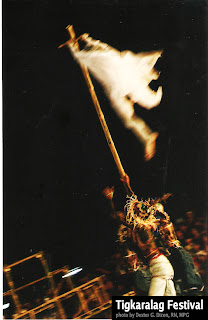 |
The Jaro Belfry;
viewed from the main entrance of
the Jaro Metropolitan Cathedral |
Historical Facts:
The Jaro belfry is one of the few belfries in the Philippines that separately stands from the church. During the Spanish colonization,
the belfry served as watchtower against invaders. It was believed that the tower was built sometime in 1744. The structure standing between the Jaro Metropolitan Cathedral and the Jaro Plaza is made of bricks and limestone blocks. Jaro as the center of religious faith in Western Visayas (Philippines) was a city independent from the City of Iloilo. On July 17, 1787, the campanario was heavily damaged by a strong earthquake. The reconstruction of the belfry only began in 1833 under the supervision of Fr. Jesse Alvarez, an Augustinian.
Between 1933-1881, another
earthquake hit and caused damage to the belfry in Jaro. Msgr. Mariano Cuartero, the first bishop of Jaro, had this completely restored in 1881. Another reconstruction was done to the Jaro belfry when it suffered from its third major destruction on January 25, 1948 - earthquake named Lady Caycay swept through the entire Panay Island.
 |
The Jaro Belfry at the back of the Statue of Filipino Hero
Graciano Lopez -Jaena, the great son of Jaro |
|
|
The
reconstruction of the Jaro Belfry began in the later part of 1990s under the supervision of the National Historical Institute. It is intended as a viewing deck and tourist center.
The Challenge:
 |
| The glassed - window of the belfry - viewing area |
October 03, 2010 (Sunday) 8AM, with no signs of restrictions to trespassers was seen from the
entrance of the Jaro Belfry, added the fact that the main door was wide open, this writer decided to go inside the belfry and see what's inside of it. The curiosity was triggered when this writer saw an aerial shot of the cathedral that was taken in the belfry itself few days ago.
 |
| way to the top of the tower |
Going up to the tower's peak is no easy. You have to conquer your fear of heights, believe in your faith and focus to your passion (in my case, it's photography). First, you should take the courage to climb the rusty-continuous-steal-stairs (you should carefully watch your steps);
Second, you have no choice, but to hold into the dirty bars while taking your steps up to the tower (never mind the dirt caused by bats living inside the belfry);
 |
| this is what can you see inside the tower |
Third, sustain the smell of the waste that came out from those flying settlers inside the tower - the Bats. Though I'm sweating with shaking knees until I reached the top, I'm proud to have made it , took photos and panoramic shots of this historic district of Iloilo City.
 |
| Panoramic view of the Jaro Metropolitan Cathedral viewed from the Jaro Belfry |
This writer wishes that the tower will soon be opened for tourists, and locals who would like to view the city-scapes. And as much I am wishing this, reconstruction of stairs and ways to the top of the tower should be made first for everybody's safety.
We, in experienceiloilo.com, do not wish you to search and explore places.
We DARE you to Experience!


















































